| Listing 1 - 9 of 9 |
Sort by
|
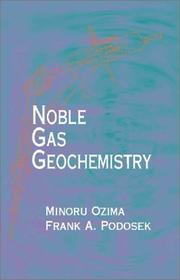
ISBN: 1107123437 0511041608 1280433310 9786610433315 0511176333 0511157118 0511329539 0511545983 0511043821 9780511041600 9780521803663 0521803667 9781107123434 9781280433313 6610433313 9780511176333 9780511157110 9780511329531 9780511545986 9780511043826 9780521021838 Year: 2002 Publisher: Cambridge New York Cambridge University Press
Abstract | Keywords | Export | Availability | Bookmark
 Loading...
Loading...Choose an application
- Reference Manager
- EndNote
- RefWorks (Direct export to RefWorks)
Noble Gas Geochemistry discusses the fundamental concepts of using noble gases to solve problems in the earth and planetary sciences. The discipline offers a powerful and unique tool in resolving problems such as the origin of the solar system, evolution of the planets, earth formation, mantle evolution and dynamics, atmospheric degassing and evolution, ocean circulation, dynamics of aquifer systems, and numerous applications to other geological problems. This book gives a comprehensive description of the physical chemistry and cosmochemistry of noble gases, before leading on to applications for problem-solving in the earth and planetary sciences. There have been many developments in the use of the noble gases since publication of the first edition of this book in 1983. This second edition has been fully revised and updated. The book will be invaluable to graduate students and researchers in the earth and planetary sciences who use noble gas geochemistry techniques.
Gases, Rare. --- Geochemistry. --- Chemical composition of the earth --- Chemical geology --- Geological chemistry --- Geology, Chemical --- Chemistry --- Earth sciences --- Elements, Inert --- Gases, Inert --- Gases, Noble --- Inert elements --- Inert gases --- Noble gases --- Rare gases --- Nonmetals
Periodical
Abstract | Keywords | Export | Availability | Bookmark
 Loading...
Loading...Choose an application
- Reference Manager
- EndNote
- RefWorks (Direct export to RefWorks)
Geophysics --- Geochemistry --- Earth sciences --- Geodesy --- Astrophysics --- Astrophysics. --- Earth sciences. --- Geochemistry. --- Geodesy. --- Geophysics. --- Geological physics --- Terrestrial physics --- Degrees of latitude and longitude --- Geodetics --- Chemical composition of the earth --- Chemical geology --- Geological chemistry --- Geology, Chemical --- Geosciences --- Astronomical physics --- Physics --- Geomatics --- Mathematical geography --- Surveying --- Chemistry --- Environmental sciences --- Physical sciences --- Astronomy --- Cosmic physics
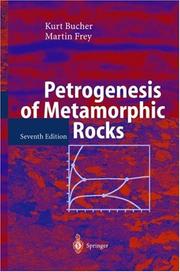
ISBN: 3540431306 3662049163 3662049147 9783540431305 Year: 2002 Publisher: Berlin: Springer,
Abstract | Keywords | Export | Availability | Bookmark
 Loading...
Loading...Choose an application
- Reference Manager
- EndNote
- RefWorks (Direct export to RefWorks)
Metamorphic rocks make up the largest volume of the Earth. They systematically change their mineralogical composition as a result of tecto-thermal events. The outstanding feature of the 7th edition of this book is the large number of phase diagrams showing the stability relations among minerals and groups of minerals found in metamorphic rocks. The diagrams help to determine the pressure and temperature conditions under which a given collected set of metamorphic rocks may have formed. More than half of the chapters have been completely rewritten or revised. All figures have been edited and improved and recent advances in the field such as multiequilibria thermobarometry and pseudosections were incorporated in the text. The bibliography has been revised and extended, new research publications have been included. Brief reviews of relevant software and web addresses for downloads have also been integrated in this new edition. Graduate students will find in depth information on the origin, significance and genesis of metamorphic rocks.
Metamorphic rocks. --- Rocks, Metamorphic. --- Metamorphic rocks --- Rocks, Metamorphic --- Rocks --- Geology. --- Mineralogy. --- Geochemistry. --- Geophysics. --- Geography. --- Geophysics/Geodesy. --- Geography, general. --- Cosmography --- Earth sciences --- World history --- Geological physics --- Terrestrial physics --- Physics --- Chemical composition of the earth --- Chemical geology --- Geological chemistry --- Geology, Chemical --- Chemistry --- Physical geology --- Crystallography --- Minerals --- Geognosy --- Geoscience --- Natural history
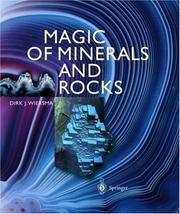
ISBN: 3540210539 3642622518 3642186955 Year: 2002 Publisher: Berlin Springer
Abstract | Keywords | Export | Availability | Bookmark
 Loading...
Loading...Choose an application
- Reference Manager
- EndNote
- RefWorks (Direct export to RefWorks)
Magic of Minerals and Rocks, featuring 135 splendid color photographs, ranges from vast rock-landscapes recorded in Europe, America, Australia, and Iceland right down to finely detailed images of a few square millimeters. Close-ups of crystals, gems, and fossils are alternated with micro-images of the minute textures and patterns that emerge from thin, translucent sections of rocks and minerals. Literally, as well as figuratively Dirk Wiersma, the photographer, 'zooms in' on the subject matter, leading the reader deeper into various spaces of surprising new forms and perspectives, at times abstract, at other times (pseudo)realistic. Often, striking similarities are revealed between subjects that are ostensibly of entirely different natures and dimensions. The short, accompanying texts are written in a style that is accessible and appealing to a general audience, while also providing the necessary factual information.
Mineralen --- Gesteenten --- Minerals --- Rocks --- Petrology --- Stone --- Mineralogy --- Mines and mineral resources --- Mineralogy. --- Earth sciences. --- Geochemistry. --- Geology. --- Sedimentology. --- Earth Sciences, general. --- Geognosy --- Geoscience --- Earth sciences --- Natural history --- Chemical composition of the earth --- Chemical geology --- Geological chemistry --- Geology, Chemical --- Chemistry --- Geosciences --- Environmental sciences --- Physical sciences --- Physical geology --- Crystallography --- Crags (Rocks)

ISBN: 1402007183 9781402007187 0306481634 Year: 2002 Publisher: Dordrecht ; Boston : Kluwer Academic,
Abstract | Keywords | Export | Availability | Bookmark
 Loading...
Loading...Choose an application
- Reference Manager
- EndNote
- RefWorks (Direct export to RefWorks)
Soil Formation deals with qualitative and quantitative aspects of soil formation (or pedogenesis) and the underlying chemical, biological, and physical processes. The starting point of the text is the process - and not soil classification. Effects of weathering and new formation of minerals, mobilisation, transport, and breakdown or immobilisation of dissolved and suspended compounds are discussed. Soil processes and profiles are discussed in relation to the landscape, the geosphere, and the biosphere. Emphasis lies on the universality of soil-forming processes in past and present, and on the soil as a dynamic entity that forms part of the total environment. Complexity of genetic processes in time and space is given much attention. The text gives many examples from literature and places some in a new light. The reader is guided through the subject matter by a large number of questions and problems to help understand and synthesis the material. Answers to all questions are included. This second edition has been updated to reflect recent discoveries. Printing errors have been corrected, and new photographs support the text.
Soil formation --- Soil formation. --- Sols --- Formation --- EPUB-LIV-FT SPRINGER-B --- Environment. --- Geochemistry. --- Soil science. --- Soil conservation. --- Soil Science & Conservation. --- Chemical composition of the earth --- Chemical geology --- Geological chemistry --- Geology, Chemical --- Chemistry --- Earth sciences --- Conservation of soil --- Erosion control, Soil --- Soil erosion --- Soil erosion control --- Soils --- Agricultural conservation --- Soil management --- Pedology (Soil science) --- Agriculture --- Control --- Prevention --- Conservation --- Formation, Soil --- Pedogenesis --- Soil genesis --- Weathering
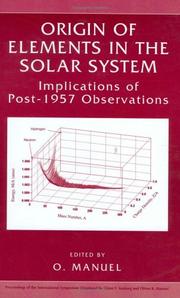
ISBN: 1280205342 9786610205349 0306469278 0306465620 Year: 2002 Publisher: New York, NY : Springer US : Imprint: Springer,
Abstract | Keywords | Export | Availability | Bookmark
 Loading...
Loading...Choose an application
- Reference Manager
- EndNote
- RefWorks (Direct export to RefWorks)
Based on an American Chemical Society Symposium organized by Professors Glenn Seaborg and Oliver Manuel, this volume provides a comprehensive record of different views on this important subject at the end of the 20th century. They have assembled a blend of highly respected experimentalists and theorists from astronomy, geology, meteoritics, planetology and nuclear chemistry and physics to discuss the origin of elements in the solar system. The intent was to include all points of view and let history judge their validity.
Cosmochemistry --- Nucleosynthesis --- Astrophysics --- Nuclear chemistry. --- Planetology. --- Chemistry, inorganic. --- Nuclear physics. --- Geochemistry. --- Nuclear Chemistry. --- Inorganic Chemistry. --- Nuclear Physics, Heavy Ions, Hadrons. --- Astrophysics and Astroparticles. --- Inorganic chemistry. --- Heavy ions. --- Astrophysics. --- Astronomical physics --- Astronomy --- Cosmic physics --- Physics --- Chemical composition of the earth --- Chemical geology --- Geological chemistry --- Geology, Chemical --- Chemistry --- Earth sciences --- Ions --- Atomic nuclei --- Atoms, Nuclei of --- Nucleus of the atom --- Inorganic chemistry --- Inorganic compounds --- Planetary sciences --- Planetology --- Chemistry, Nuclear --- Chemistry, Physical and theoretical --- Nucléosynthèse. --- Cosmochimie. --- Système solaire --- Nucléosynthèse. --- Système solaire --- Planetary science. --- Chemistry, Inorganic.
Book
ISBN: 0306481030 Year: 2002 Publisher: Dordrecht ; Boston : Kluwer Academic Publishers,
Abstract | Keywords | Export | Availability | Bookmark
 Loading...
Loading...Choose an application
- Reference Manager
- EndNote
- RefWorks (Direct export to RefWorks)
Modern Biogeochemistry is aimed to generalize modern ideas of biogeochemical developments during the last decades. It is designed to support a general course in biogeochemistry, and as such, is likely to have a broad market among the many universities and colleges that are adding such courses to their curricula. This book aims to supplement the existing textbooks by providing modern understanding of biogeochemistry, from evolutionary biogeochemistry to practical applications of biogeochemical ideas such as human biogeochemistry, biogeochemical standards and biogeochemical technologies. To a certain extent this textbook is a summary of both scientific results of various authors and classes in biogeochemistry, that have been given to students by authors during the last 5 to 10 years at different universities throughout the world such as Cornell, Moscow, Seoul and Bangkok. Biogeochemistry is becoming an increasingly popular subject for graduate and postgraduate education. Courses in ecology, geography, biology, chemistry, environmental science, public health and environmental engineering all tend to have a biogeochemical component in their syllabuses to a greater or lesser extent.
Earth sciences. --- Physical chemistry. --- Geochemistry. --- Public health. --- Ecology. --- Earth Sciences. --- Physical Chemistry. --- Public Health. --- Ecology . --- Community health --- Health services --- Hygiene, Public --- Hygiene, Social --- Public health services --- Public hygiene --- Social hygiene --- Health --- Human services --- Biosecurity --- Health literacy --- Medicine, Preventive --- National health services --- Sanitation --- Balance of nature --- Biology --- Bionomics --- Ecological processes --- Ecological science --- Ecological sciences --- Environment --- Environmental biology --- Oecology --- Environmental sciences --- Population biology --- Chemistry, Theoretical --- Physical chemistry --- Theoretical chemistry --- Chemistry --- Chemical composition of the earth --- Chemical geology --- Geological chemistry --- Geology, Chemical --- Earth sciences --- Ecology --- Biogeochemistry. --- Biogeochemical cycles. --- Biogeochemistry --- Cycles --- Biochemistry --- Geochemistry
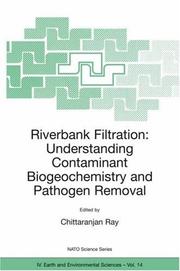
ISBN: 1402009542 1402009550 940100479X Year: 2002 Volume: v. 14 Publisher: Dordrecht ; Boston ; London Brussels Kluwer Academic Publishers NATO Scientific Affairs Division
Abstract | Keywords | Export | Availability | Bookmark
 Loading...
Loading...Choose an application
- Reference Manager
- EndNote
- RefWorks (Direct export to RefWorks)
Riverbank filtration is widely used in Europe and to some extent in the United States for the public water supply. It is a cost-effective and realisable treatment technology in which horizontal and vertical wells pump a mixture of ground water and induced surface water from a river. This book describes the biogeochemical issues involved in contaminant removal from surface water and the mechanisms of pathogen removal. Specifically, the following three points are considered: *The role of hydrogeological and well construction factors in the development of redox zones at bank filtration sites and the resulting impacts on contaminant removal. *The mechanisms of pathogen removal, including the processes, colloid filtration, die-away, decay, and predation. *The status of riverbank filtration processes in NATO partner countries.
Water --- Biochemistry --- Drinking water --- Biochimie --- Purification --- Riverbank filtration --- Congresses. --- Microbial removal --- Congresses --- Congrès --- Congrès --- Environmental sciences. --- Ecology . --- Air pollution. --- Geochemistry. --- Hydrogeology. --- Water pollution. --- Environmental Science and Engineering. --- Ecology. --- Atmospheric Protection/Air Quality Control/Air Pollution. --- Waste Water Technology / Water Pollution Control / Water Management / Aquatic Pollution. --- Aquatic pollution --- Fresh water --- Fresh water pollution --- Freshwater pollution --- Inland water pollution --- Lake pollution --- Lakes --- Reservoirs --- River pollution --- Rivers --- Stream pollution --- Water contamination --- Water pollutants --- Water pollution --- Pollution --- Waste disposal in rivers, lakes, etc. --- Geohydrology --- Geology --- Hydrology --- Groundwater --- Chemical composition of the earth --- Chemical geology --- Geological chemistry --- Geology, Chemical --- Chemistry --- Earth sciences --- Air --- Air contaminants --- Air pollutants --- Air pollution --- Air pollution control --- Air toxics --- Airborne pollutants --- Atmosphere --- Contaminants, Air --- Control of air pollution --- Pollutants, Air --- Toxics, Air --- Air quality --- Atmospheric deposition --- Balance of nature --- Biology --- Bionomics --- Ecological processes --- Ecological science --- Ecological sciences --- Environment --- Environmental biology --- Oecology --- Environmental sciences --- Population biology --- Environmental science --- Science --- Control --- Ecology
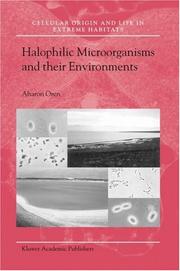
ISBN: 1280551097 9786610551095 0306480530 1402008295 Year: 2002 Publisher: Dordrecht, the Netherlands ; Boston, Massachusetts : Kluwer Academic Publishers,
Abstract | Keywords | Export | Availability | Bookmark
 Loading...
Loading...Choose an application
- Reference Manager
- EndNote
- RefWorks (Direct export to RefWorks)
"This water" he told me, "runs out to the eastern region, and flows into the Arabah; and when it comes into the sea, into the sea of foul waters [i. e. , the Dead Sea], the water will become wholesome. Every living creature that swarms will be able to live wherever this stream goes; the fish will be very abundant once these waters have reached there. It will be wholesome, and everything will live wherever this stream goes. Fishermen shall stand beside it all the way from En-gedi to En-eglaim; it shall be a place for drying nets; and the fish will be of various kinds [and] most plentiful, like the fish of the Great Sea. " Ezekiel’s prophecy (Ezekiel 47: 8-10) for revival and purification of the Dead Sea waters This new book on "Halophilic Microorganisms and their Environments" is the fifth volume in the COLE series (Cellular Origin and Life in Extreme Habitats (see: http://www. wkap. nl/prod/s/COLE). In the previous books we covered aspects of enigmatic microorganisms, microbial diversity, astrobiology, and symbiosis, so this book on halophilic microbes adds a fitting link to the rest of series' books. Since ancient times hypersaline habitats have been considered extreme environments, and some were thought not to sustain life at all. Yet, every organism requires salt for its existence. Salty places have been compared to an environment of extinction (e. g. , the Dead Sea).
Organisms --- Adaptation, Biological --- Environmental Microbiology --- Sodium Compounds --- Physiological Processes --- Euryarchaeota --- Chlorides --- Hydrochloric Acid --- Public Health --- Physiological Phenomena --- Microbiology --- Biological Processes --- Archaea --- Inorganic Chemicals --- Chlorine Compounds --- Chemicals and Drugs --- Biology --- Phenomena and Processes --- Biological Phenomena --- Environment and Public Health --- Biological Science Disciplines --- Health Care --- Natural Science Disciplines --- Disciplines and Occupations --- Water Microbiology --- Sodium Chloride --- Adaptation, Physiological --- Bacteria --- Halobacteriales --- Health & Biological Sciences --- Microbiology & Immunology --- Microbial ecology. --- Nature conservation. --- Geochemistry. --- Aquatic ecology . --- Biochemistry. --- Microbial Ecology. --- Nature Conservation. --- Freshwater & Marine Ecology. --- Biochemistry, general. --- Biological chemistry --- Chemical composition of organisms --- Physiological chemistry --- Chemistry --- Medical sciences --- Aquatic biology --- Ecology --- Chemical composition of the earth --- Chemical geology --- Geological chemistry --- Geology, Chemical --- Earth sciences --- Conservation of nature --- Nature --- Nature protection --- Protection of nature --- Conservation of natural resources --- Applied ecology --- Conservation biology --- Endangered ecosystems --- Natural areas --- Environmental microbiology --- Microorganisms --- Composition --- Conservation --- Halophilic microorganisms. --- Micro-organisms, Halophilic --- Halophilic organisms
| Listing 1 - 9 of 9 |
Sort by
|

 Search
Search Feedback
Feedback About UniCat
About UniCat  Help
Help News
News